[English] 日本語
 Yorodumi
Yorodumi- PDB-1p9d: High-resolution structure of the complex of HHR23A ubiquitin-like... -
+ Open data
Open data
- Basic information
Basic information
| Entry | Database: PDB / ID: 1p9d | ||||||
|---|---|---|---|---|---|---|---|
| Title | High-resolution structure of the complex of HHR23A ubiquitin-like domain and the C-terminal ubiquitin-interacting motif of proteasome subunit S5a | ||||||
 Components Components |
| ||||||
 Keywords Keywords |  REPLICATION / protein-peptide complex REPLICATION / protein-peptide complex | ||||||
| Function / homology |  Function and homology information Function and homology informationregulation of proteasomal ubiquitin-dependent protein catabolic process / proteasome accessory complex / proteasome regulatory particle, base subcomplex / Regulation of ornithine decarboxylase (ODC) / Cross-presentation of soluble exogenous antigens (endosomes) /  Somitogenesis / Somitogenesis /  proteasome binding / ubiquitin-specific protease binding / polyubiquitin modification-dependent protein binding / positive regulation of viral genome replication ...regulation of proteasomal ubiquitin-dependent protein catabolic process / proteasome accessory complex / proteasome regulatory particle, base subcomplex / Regulation of ornithine decarboxylase (ODC) / Cross-presentation of soluble exogenous antigens (endosomes) / proteasome binding / ubiquitin-specific protease binding / polyubiquitin modification-dependent protein binding / positive regulation of viral genome replication ...regulation of proteasomal ubiquitin-dependent protein catabolic process / proteasome accessory complex / proteasome regulatory particle, base subcomplex / Regulation of ornithine decarboxylase (ODC) / Cross-presentation of soluble exogenous antigens (endosomes) /  Somitogenesis / Somitogenesis /  proteasome binding / ubiquitin-specific protease binding / polyubiquitin modification-dependent protein binding / positive regulation of viral genome replication / positive regulation of cell cycle / proteasome binding / ubiquitin-specific protease binding / polyubiquitin modification-dependent protein binding / positive regulation of viral genome replication / positive regulation of cell cycle /  proteasome complex / Josephin domain DUBs / Regulation of activated PAK-2p34 by proteasome mediated degradation / Autodegradation of Cdh1 by Cdh1:APC/C / proteasome complex / Josephin domain DUBs / Regulation of activated PAK-2p34 by proteasome mediated degradation / Autodegradation of Cdh1 by Cdh1:APC/C /  ubiquitin binding / APC/C:Cdc20 mediated degradation of Securin / Asymmetric localization of PCP proteins / SCF-beta-TrCP mediated degradation of Emi1 / NIK-->noncanonical NF-kB signaling / Ubiquitin-dependent degradation of Cyclin D / AUF1 (hnRNP D0) binds and destabilizes mRNA / TNFR2 non-canonical NF-kB pathway / Assembly of the pre-replicative complex / Degradation of DVL / Vpu mediated degradation of CD4 / Ubiquitin Mediated Degradation of Phosphorylated Cdc25A / Dectin-1 mediated noncanonical NF-kB signaling / Hh mutants are degraded by ERAD / Cdc20:Phospho-APC/C mediated degradation of Cyclin A / nucleotide-excision repair / Degradation of GLI1 by the proteasome / Degradation of AXIN / Defective CFTR causes cystic fibrosis / Activation of NF-kappaB in B cells / Hedgehog ligand biogenesis / Negative regulation of NOTCH4 signaling / GSK3B and BTRC:CUL1-mediated-degradation of NFE2L2 / G2/M Checkpoints / Vif-mediated degradation of APOBEC3G / Hedgehog 'on' state / DNA Damage Recognition in GG-NER / Autodegradation of the E3 ubiquitin ligase COP1 / Regulation of RUNX3 expression and activity / Degradation of GLI2 by the proteasome / GLI3 is processed to GLI3R by the proteasome / FBXL7 down-regulates AURKA during mitotic entry and in early mitosis / MAPK6/MAPK4 signaling / protein destabilization / APC/C:Cdh1 mediated degradation of Cdc20 and other APC/C:Cdh1 targeted proteins in late mitosis/early G1 / ABC-family proteins mediated transport / Degradation of beta-catenin by the destruction complex / Oxygen-dependent proline hydroxylation of Hypoxia-inducible Factor Alpha / CDK-mediated phosphorylation and removal of Cdc6 / CLEC7A (Dectin-1) signaling / SCF(Skp2)-mediated degradation of p27/p21 / Formation of Incision Complex in GG-NER / Regulation of expression of SLITs and ROBOs / ubiquitin binding / APC/C:Cdc20 mediated degradation of Securin / Asymmetric localization of PCP proteins / SCF-beta-TrCP mediated degradation of Emi1 / NIK-->noncanonical NF-kB signaling / Ubiquitin-dependent degradation of Cyclin D / AUF1 (hnRNP D0) binds and destabilizes mRNA / TNFR2 non-canonical NF-kB pathway / Assembly of the pre-replicative complex / Degradation of DVL / Vpu mediated degradation of CD4 / Ubiquitin Mediated Degradation of Phosphorylated Cdc25A / Dectin-1 mediated noncanonical NF-kB signaling / Hh mutants are degraded by ERAD / Cdc20:Phospho-APC/C mediated degradation of Cyclin A / nucleotide-excision repair / Degradation of GLI1 by the proteasome / Degradation of AXIN / Defective CFTR causes cystic fibrosis / Activation of NF-kappaB in B cells / Hedgehog ligand biogenesis / Negative regulation of NOTCH4 signaling / GSK3B and BTRC:CUL1-mediated-degradation of NFE2L2 / G2/M Checkpoints / Vif-mediated degradation of APOBEC3G / Hedgehog 'on' state / DNA Damage Recognition in GG-NER / Autodegradation of the E3 ubiquitin ligase COP1 / Regulation of RUNX3 expression and activity / Degradation of GLI2 by the proteasome / GLI3 is processed to GLI3R by the proteasome / FBXL7 down-regulates AURKA during mitotic entry and in early mitosis / MAPK6/MAPK4 signaling / protein destabilization / APC/C:Cdh1 mediated degradation of Cdc20 and other APC/C:Cdh1 targeted proteins in late mitosis/early G1 / ABC-family proteins mediated transport / Degradation of beta-catenin by the destruction complex / Oxygen-dependent proline hydroxylation of Hypoxia-inducible Factor Alpha / CDK-mediated phosphorylation and removal of Cdc6 / CLEC7A (Dectin-1) signaling / SCF(Skp2)-mediated degradation of p27/p21 / Formation of Incision Complex in GG-NER / Regulation of expression of SLITs and ROBOs /  kinase binding / FCERI mediated NF-kB activation / Interleukin-1 signaling / Regulation of PTEN stability and activity / Orc1 removal from chromatin / Regulation of RAS by GAPs / Separation of Sister Chromatids / Regulation of RUNX2 expression and activity / UCH proteinases / The role of GTSE1 in G2/M progression after G2 checkpoint / KEAP1-NFE2L2 pathway / positive regulation of proteasomal ubiquitin-dependent protein catabolic process / Antigen processing: Ubiquitination & Proteasome degradation / kinase binding / FCERI mediated NF-kB activation / Interleukin-1 signaling / Regulation of PTEN stability and activity / Orc1 removal from chromatin / Regulation of RAS by GAPs / Separation of Sister Chromatids / Regulation of RUNX2 expression and activity / UCH proteinases / The role of GTSE1 in G2/M progression after G2 checkpoint / KEAP1-NFE2L2 pathway / positive regulation of proteasomal ubiquitin-dependent protein catabolic process / Antigen processing: Ubiquitination & Proteasome degradation /  single-stranded DNA binding / Downstream TCR signaling / single-stranded DNA binding / Downstream TCR signaling /  Neddylation / RUNX1 regulates transcription of genes involved in differentiation of HSCs / ER-Phagosome pathway / proteasome-mediated ubiquitin-dependent protein catabolic process / damaged DNA binding / molecular adaptor activity / Ub-specific processing proteases / intracellular membrane-bounded organelle / Neddylation / RUNX1 regulates transcription of genes involved in differentiation of HSCs / ER-Phagosome pathway / proteasome-mediated ubiquitin-dependent protein catabolic process / damaged DNA binding / molecular adaptor activity / Ub-specific processing proteases / intracellular membrane-bounded organelle /  Golgi apparatus / protein-containing complex / Golgi apparatus / protein-containing complex /  RNA binding / RNA binding /  nucleoplasm / identical protein binding / nucleoplasm / identical protein binding /  nucleus / nucleus /  cytosol / cytosol /  cytoplasm cytoplasmSimilarity search - Function | ||||||
| Biological species |   Homo sapiens (human) Homo sapiens (human) | ||||||
| Method |  SOLUTION NMR / SOLUTION NMR /  simulated annealing simulated annealing | ||||||
 Authors Authors | Mueller, T.D. / Feigon, J. | ||||||
 Citation Citation |  Journal: Embo J. / Year: 2003 Journal: Embo J. / Year: 2003Title: Structural determinants for the binding of ubiquitin-like domains to the proteasome. Authors: Mueller, T.D. / Feigon, J. | ||||||
| History |
|
- Structure visualization
Structure visualization
| Structure viewer | Molecule:  Molmil Molmil Jmol/JSmol Jmol/JSmol |
|---|
- Downloads & links
Downloads & links
- Download
Download
| PDBx/mmCIF format |  1p9d.cif.gz 1p9d.cif.gz | 345.8 KB | Display |  PDBx/mmCIF format PDBx/mmCIF format |
|---|---|---|---|---|
| PDB format |  pdb1p9d.ent.gz pdb1p9d.ent.gz | 298.6 KB | Display |  PDB format PDB format |
| PDBx/mmJSON format |  1p9d.json.gz 1p9d.json.gz | Tree view |  PDBx/mmJSON format PDBx/mmJSON format | |
| Others |  Other downloads Other downloads |
-Validation report
| Arichive directory |  https://data.pdbj.org/pub/pdb/validation_reports/p9/1p9d https://data.pdbj.org/pub/pdb/validation_reports/p9/1p9d ftp://data.pdbj.org/pub/pdb/validation_reports/p9/1p9d ftp://data.pdbj.org/pub/pdb/validation_reports/p9/1p9d | HTTPS FTP |
|---|
-Related structure data
- Links
Links
- Assembly
Assembly
| Deposited unit | 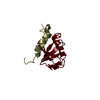
| |||||||||
|---|---|---|---|---|---|---|---|---|---|---|
| 1 |
| |||||||||
| NMR ensembles |
|
- Components
Components
| #1: Protein/peptide | Mass: 4916.343 Da / Num. of mol.: 1 / Fragment: C-terminal ubiquitin-interacting motif, PUBS2 Source method: isolated from a genetically manipulated source Source: (gene. exp.)   Homo sapiens (human) / Gene: PSMD4 OR MCB1 / Production host: Homo sapiens (human) / Gene: PSMD4 OR MCB1 / Production host:   Escherichia coli (E. coli) / References: UniProt: P55036 Escherichia coli (E. coli) / References: UniProt: P55036 |
|---|---|
| #2: Protein | Mass: 8953.532 Da / Num. of mol.: 1 / Fragment: ubiquitin-like domain Source method: isolated from a genetically manipulated source Source: (gene. exp.)   Homo sapiens (human) / Gene: RAD23A / Production host: Homo sapiens (human) / Gene: RAD23A / Production host:   Escherichia coli (E. coli) / References: UniProt: P54725 Escherichia coli (E. coli) / References: UniProt: P54725 |
-Experimental details
-Experiment
| Experiment | Method:  SOLUTION NMR SOLUTION NMR | ||||||||||||||||
|---|---|---|---|---|---|---|---|---|---|---|---|---|---|---|---|---|---|
| NMR experiment |
| ||||||||||||||||
| NMR details | Text: The structure was determined using triple-resonance NMR spectroscopy |
- Sample preparation
Sample preparation
| Details |
| |||||||||
|---|---|---|---|---|---|---|---|---|---|---|
| Sample conditions | Ionic strength: 150mM / pH: 6.5 / Pressure: ambient / Temperature: 300 K | |||||||||
Crystal grow | *PLUS Method: other / Details: NMR |
-NMR measurement
| Radiation | Protocol: SINGLE WAVELENGTH / Monochromatic (M) / Laue (L): M | |||||||||||||||
|---|---|---|---|---|---|---|---|---|---|---|---|---|---|---|---|---|
| Radiation wavelength | Relative weight: 1 | |||||||||||||||
| NMR spectrometer |
|
- Processing
Processing
| NMR software |
| ||||||||||||||||||||
|---|---|---|---|---|---|---|---|---|---|---|---|---|---|---|---|---|---|---|---|---|---|
| Refinement | Method:  simulated annealing / Software ordinal: 1 simulated annealing / Software ordinal: 1 Details: The structures are based on a total of 2066 restraints, 1999 are NOE-derived distance restraints, of which 58 are intermolecular. For the S5a ubiquitin-interacting motif only the residues ...Details: The structures are based on a total of 2066 restraints, 1999 are NOE-derived distance restraints, of which 58 are intermolecular. For the S5a ubiquitin-interacting motif only the residues 270 to 301 were included in the structure calculations due to disorder of the flexible N- and C-termini. | ||||||||||||||||||||
| NMR representative | Selection criteria: lowest energy | ||||||||||||||||||||
| NMR ensemble | Conformer selection criteria: structures with the lowest energy Conformers calculated total number: 30 / Conformers submitted total number: 10 |
 Movie
Movie Controller
Controller





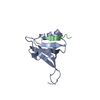
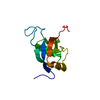
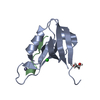

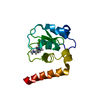

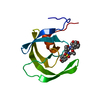

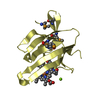
 PDBj
PDBj






